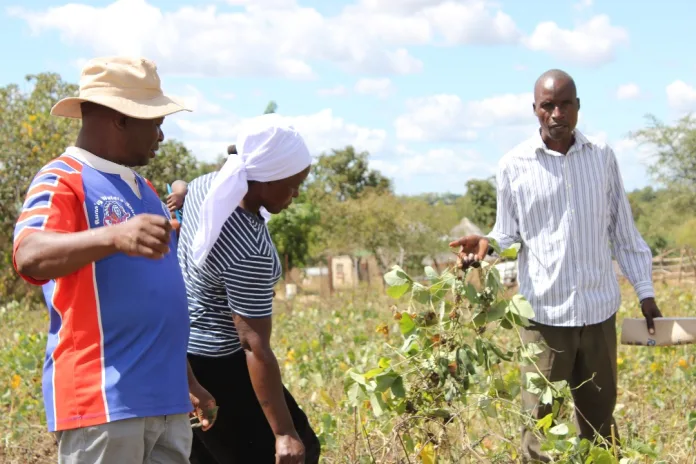By Johnson Siamachira
Harare, (New Ziana) — As the scorching sun beats down on parched earth during the dry seasons in rural Zimbabwe, smallholder farmers face multiple daunting challenges to look after their livestock.
A backbone of rural livelihoods, livestock often suffer due to insufficient feed and water.
But hope for a solution now shines on the horizon as the International Livestock Research Institute (ILRI) ground-breaks nine climate-resilient and cost-effective feed supplements designed to sustain cattle, goats, and sheep during drier periods.
The ILRI’s new forage-based feeds were evaluated in farmer-managed trials in different parts of the country. These innovative feeds, developed from hardy forage legumes like Velvet Beans (Mucuna pruriens) and Lablab (Lablab purpureus), provide a sustainable alternative to the costly commercial feeds that have long burdened farmers.
The initiative boosts livestock productivity and climate resilience by introducing drought-tolerant fodder crops. While traditional feeds, primarily composed of cereal and oilseed byproducts, can be prohibitively expensive and difficult to access, the ILRI’s new formulations promise to empower farmers, improve livestock health, and enhance their income.
The international organization works to improve food security and reduce poverty through research for better and more sustainable use of livestock.
The ILRI’s initiative is not just about livestock feed; it’s a lifeline for the 5.74 million cattle and 3.5 million goats in Zimbabwe, the bulk of which is owned by smallholder farmers.
With the government aiming to double the beef herd by 2030, these climate-relevant feeds could significantly impact productivity, reduce livestock mortality rates, and promote economic resilience in rural communities.
Livestock provides income and employment to farmers, agricultural service providers, and other actors involved in the value chain.
The country’s livestock production system is characterised by small-scale subsistence farming. Despite the importance of livestock to rural livelihoods, the sector’s productivity remains low, a situation that is linked to feed unavailability and cost, poor quality of animals, diseases and frequent droughts.
Climate-relevant livestock production practices such as fodder management and conservation can increase livestock productivity in Zimbabwe
In Ward 25 in Madziva area of Shamva district, in Mashonaland Central Province, smallholder farmer Willis Nyamusanduka has seen remarkable improvements in the productivity of his goat herd. “We started with 12 goats in 2021,” he recalls. “ILRI introduced us to growing forages like lablab and velvet beans. From 2023 to 2025, we’ve sold 56 goats, earning more than ever before.”
During the 2025/2026 farming season, farmers in Madziwa produced US$20 000 worth of fodder. Erenica Chikuruwo, a farmer in Murehwa district, in Mashonaland East Province, echoes Nyamusanduka’s sentiments. “Access to economic opportunities was a challenge,” she admits. Through ILRI’s trials, she learnt to cultivate drought-resistant fodder crops. “Now, we sell our cattle for better prices, thanks to ILRI’s feeds.”
Chikuruwo’s experience is emblematic of a broader struggle faced by Zimbabwean farmers. According to ILRI’s former Senior Forage Scientist, Dr. Godfrey Manyawu, “The new feeds are designed to be mixed at home, using locally available ingredients, which makes them accessible and affordable for smallholders.”
The development of these feeds stems from a 12-year research collaboration among ILRI, Agricultural Research, Innovation and Specialist Services (ARISS)), formerly Department of Research and Specialist Services, and various international organisations. The research collaboration was funded by various organizations.
The feeds were carefully formulated to ensure high protein content while remaining adaptable to Zimbabwe’s erratic climate. They have already been certified by the Fertilizer and Farm Feeds and Remedies Institute (FFFRI) in the Ministry of Lands, Agriculture, Fisheries, Water and Rural Development.
Dr. Manyawu explains: “Our formulations are based on legumes that thrive in both drought and excessive rainfall conditions. This adaptability is crucial for farmers facing the unpredictability of climate change.”
“The idea of testing new innovations has paid off. Despite the poor sandy soils in Buhera district in Manicaland Province, these fodder crops have done well!,” says Thembinkosi Baleni, ILRI’s Research Associate who was part of the research team. “This means we now have a more diverse range of fodder crop species that can be grown in these semi-arid conditions.”
Enterprising farmers in the communal areas often spend up to 70 percent of their livestock production costs on feed alone. The wholesale price of commercial feeds remains high, largely due to the reliance on imported raw materials like soya beans and cotton seed cake.
For example, early trials in Beitbridge district showed that Matabele goats maintained good body condition when supplemented with a mix of velvet bean hay and maize stover. Goats receiving these supplements achieved an average daily weight gain of 63 grammes, compared to those relying solely on natural grazing, which lost weight.
Theresa Rukuni from ARISS emphasises the importance of local engagement: “Farmers need to be involved in every step, from formulation to implementation. Our trials have shown that when farmers understand the science behind these feeds, they’re more likely to adopt them.”
In a recent trial, farmers in Murehwa district reported that using the ILRI’s 16 per cent Crude Protein Cattle Ration resulted in an average daily weight gain of 0.57 kg for beef cattle. This translates into substantial financial benefits: one farmer noted earning a net profit of nearly $138 after feeding costs were accounted for.
The government has set ambitious targets under the Livestock Recovery and Growth Plan (2021-2026) to enhance the beef herd and improve productivity.
The introduction of these climate-resilient feeds aligns perfectly with these goals, especially amid the 2024 drought that caused over 50,000 cattle deaths.
With the release of the ILRI’s innovative, improved feed supplements, smallholder farmers in Zimbabwe stand to benefit. The promise of improved livestock health and increased income could not only transform individual farms but also bolster the nation’s agricultural sector.
As farmers like Nyamusanduka prepare to implement these new technologies, hope is palpable this could be the turning point in livestock production in Zimbabwe, making the dream of sustainable farming a reality.
New Ziana



